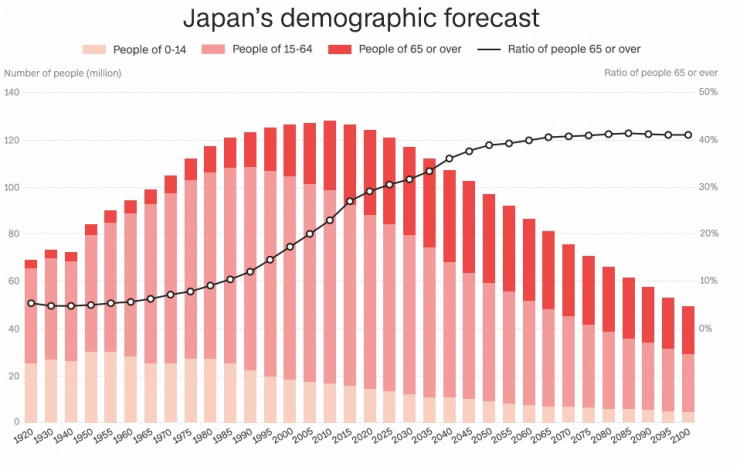Dwindling Japanese workforce
January 18, 2019 | Expert Insights

According to a government study report, it is projected that the country's workforce would decline by 20 per cent by 2040.
On an average, the country’s workforce would shrink by almost 13m people in the next twenty years without urgent action to increase the number of working women and older workers.
Background
As of October 1, 2015, the population was 127,094,745 making it the world's tenth most populous country at the time. The population had declined by 0.8 per cent from the time of the census five years ago. It was the first time it had decreased since the 1945 census. Since 2010, Japan has been experiencing net population loss due to falling birth rates and almost no immigration despite having one of the highest life expectancies in the world, at 85.00 years as of 2016 (it was 81.25 as of 2006). Based on 2012 data from the National Institute of Population and Social Security Research, Japan's population will keep declining by about one million people every year in the coming decades, which will leave Japan with a population of 42 million in 2110. More than 40 per cent of the population is expected to be over age 65 in 2060.
In the 1970s, the average Japanese woman had 2.1 kids. However, at present, the number is only 1.4 - far below the replacement rate, or where Japan needs to be to maintain its population. Out of 127 million people, there are 67,824 people over the age of 100, the highest rate of centenarians of any country in the world. Senior citizens over the age of 65 make up more than a quarter of the population. An ageing population like Japan's poses many problems.

Analysis
Recent figures published by the government based on a study reveal that Japan is likely to experience a decline in the workforce by 20 per cent by 2040. In addition, the country’s workforce would shrink by 13 million people in the next 20 years.
The Health Ministry projected figures that showed that the workforce would shrink from 65.3m in 2017 to 52.5m in 2040, a fall of 22 per cent. The ministry has not produced such long-range forecasts before. Employment in the agriculture and construction industries is expected to halve. Another study group of the labour ministry released their first official projection for the size of Japan’s workforce in 2040 and called for additional policies to boost employment and promotion of artificial intelligence as measures to sustain productivity.
The study also revealed that the number of male workers in 2040 would fall by 7.11 million from 2017, while that of females will decrease by 5.75 million. By industry, it is projected that the wholesale and retail sector will be hit the hardest, with the workforce expected to drop by 2.87 million between 2017 and 2040, followed by mining and construction with a 2.21 million fall, and manufacturing, down by 2.06 million.
However, the study also foresees that only in the medical and welfare sector, the workforce in 2040 is estimated to rise by 1.03 million, due to the country’s ageing society.
Government statistics released in December 2018, showed that the country faced its most significant natural population decline. The country also suffered a record low birth rate. An estimated number of babies born in 2018 dipped to 921,000 -- the lowest since records began in 1899 -- according to a report published by the Ministry of Health, Labour and Welfare. The number of deaths in 2018 also hit a post-war record high of 1.369 million, with a natural population decline of 448,000 -- the highest ever.
The ageing population is a massive burden on the government. Mary Brinton, a Harvard sociologist, had said that "An ageing population will mean higher costs for the government, a shortage of pension and social security-type funds, a shortage of people to care for the very aged, slow economic growth, and a shortage of young workers.”
The government will have to spend more on healthcare, coupled with a shrinking workforce and tax base, it would result in economic stagnation. Besides, among other things, that there will be too many old people and not enough young people to care for them. Japan's government recently formally passed legislation to allow more foreign workers in a move aimed at alleviating severe labour shortages that are a significant drag on the Japanese economy.
Assessment
Our assessment is that solving the ageing problem in the country must be the top priority due to its cascading effects on the Japanese economy. We feel that the dilution in immigration norms would be a boost for the economy. However, immigration comes at a risk of losing uniqueness in a culture that defines Japan. We also believe that the government must adopt policies and provide incentives for the people of the country to gradually increase the birth rate to protect the Japanese identity.








Comments